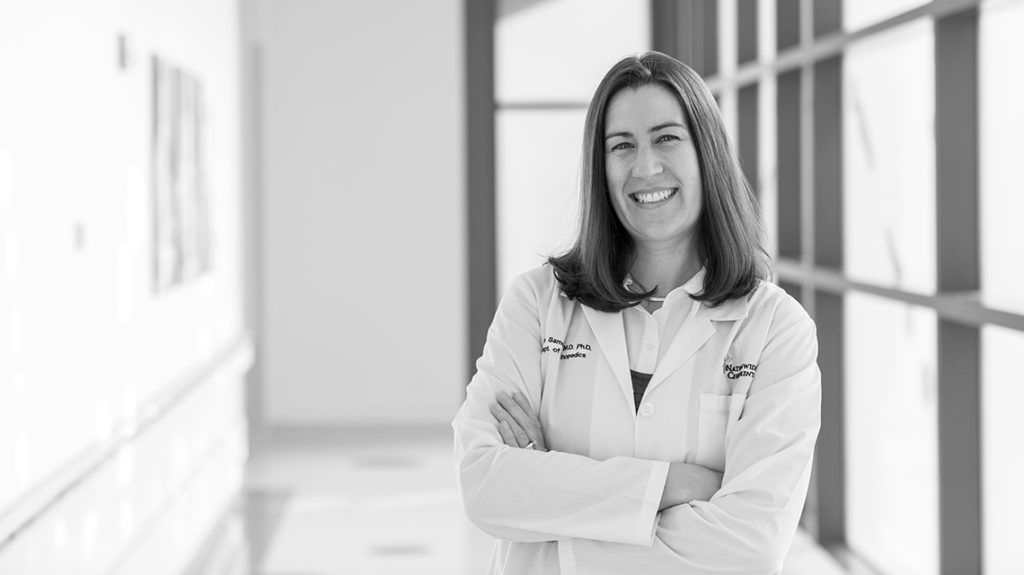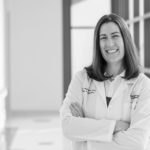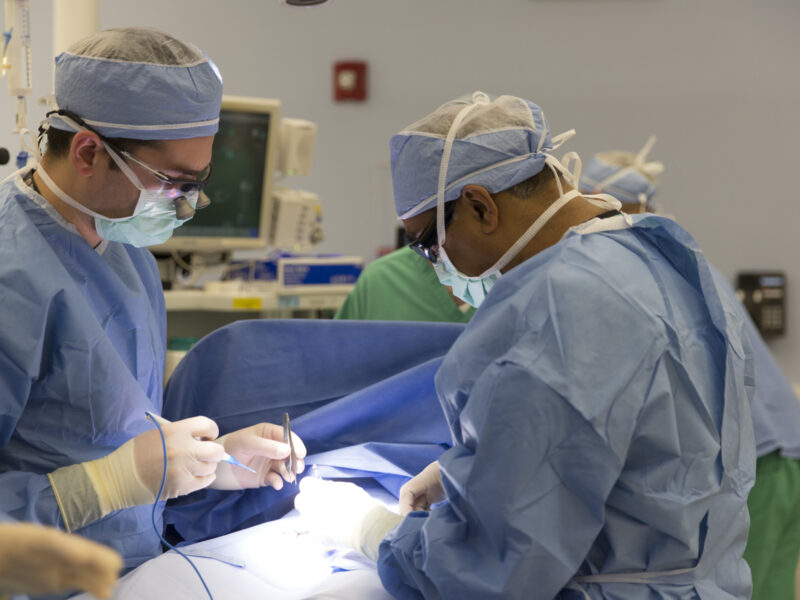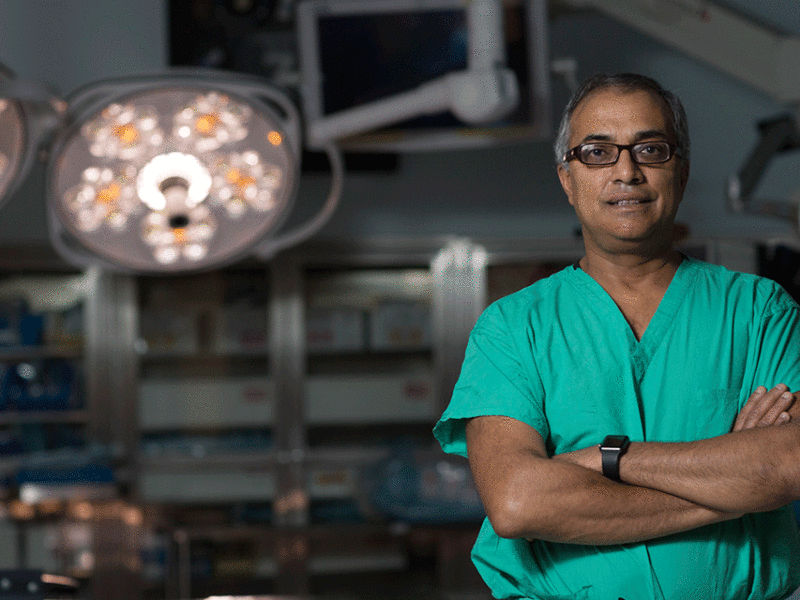She for She: Supporting Women in Orthopaedics
She for She: Supporting Women in Orthopaedics https://pediatricsnationwide.org/wp-content/uploads/2020/06/122016ds0034-samora-header-1024x575.jpg 1024 575 Julie Samora, MD, PhD Julie Samora, MD, PhD https://secure.gravatar.com/avatar/046f18da46df408fb88883823eeead0d?s=96&d=mm&r=g- June 03, 2021
- Julie Samora, MD, PhD

Julie Balch Samora, MD, PhD, MPH, an orthopaedic surgeon at Nationwide Children’s Hospital and the hospital’s associate medical director for quality, is the 2021 President of the Ruth Jackson Orthopaedic Society – the leading international organization championing women in orthopaedics. This column was adapted from her presidential address.
Shalane Flanagan is an American long-distance runner and winner of the 2017 New York City Marathon. While her athletic prowess is remarkable, her positive role-modeling, mentorship and sponsorship of other women is what makes her one of my heroines. In the early 2000s, she brought together professional female distance runners in Portland to train collectively, pushing each other to achieve successes. Of this group, 11 women made it to the Olympics.
Flanagan remains extraordinarily competitive, and aims to win, but she is team oriented. She describes how elevating other women is not done for purely altruistic purposes and explains how it’s not as lonely at the top if others are there with her.
“I thoroughly enjoy working with other women,” she was quoted saying in The New York Times. “It makes me a better athlete and person. It allows me to have more passion toward my training and racing. When we achieve great things on our own, it doesn’t feel nearly as special.”
The Times said her goal was to be “a rocket booster for the careers of women who work alongside you, while catapulting forward yourself.”
I want to promote this idea of serving as rocket boosters for other women in orthopaedics while simultaneously succeeding ourselves. This concept can be dubbed “She for She.”
There have been a number of women pioneers in medicine, who were truly alone at the time, but who have enabled us to have the careers we have today: James Barry (Miranda Steuart), MD; Elizabeth Blackwell, MD; Mary Edwards Walker, MD; Jennie Smillie Robertson, MD; Kathryn Anderson, MD; and many others. Without these women, we would not be where we are. However, my hope for our future is that we don’t have to go this road alone. My vision is that we can all work together to elevate the entire field. A rising tide lifts all boats.
My goal is that moving forward, we do not have to face the uphill battles these trailblazers did, or, at least, we do not have to face them alone. My dream is that we succeed together, with mentorship, sponsorship, collaboration and support. That is the idea of “She for She.”
Until 1970, women never made up more than 6% of any medical school class. The American College of Surgeons admitted one woman in 1913 and then no more than five women per year until 1975, making up less than 2% of the classes. In 1970, more women applied to medical school due to an increase in overall positions, the rise of the women’s movement, growing numbers of female baby boomers, and ratification of the Equal Opportunity Act.
We are making progress, as recent statistics from the American Association of Medical Colleges demonstrate: 51.5% of medical students are women, and 43.9% of full-time faculty in academic medical centers are women. However, career advancement for academic female faculty members is much slower than that of their male peers – only 26.7% of full professors are women. There remains sexism in peer review, and disparities in salary, promotion, tenure and leadership opportunities. Nonetheless, women have increasingly and successfully infiltrated the walls of academia.
How are we doing in orthopaedics? We remain the least diverse among all medical and surgical specialties, with less than 1% of female medical graduates pursuing an orthopaedic surgery residency program. Only 9% of orthopaedic faculty are female. There are only a handful of female orthopaedic department chairs.
We have had amazing women serve as presidents of the Ruth Jackson Orthopaedic Society. I have had the great pleasure in the past few years of working with the RJOS board of directors, who have done an incredible job of increasing our reach to trainees, to young faculty, to other societies, and of expanding our network overall. These collaborations are critical to provide women of all walks of life the opportunities to succeed in this magnificent specialty.
What can we do to continue to move this ball forward? We can emulate Shalane Flanagan and work together to boost each other. We can commit to “She for She.” I believe there are four areas for us to embrace.
Mentorship: Mentorship is crucial not only at the organizational level, but also at the individual level. We must mentor and be mentored. Each one of us has a role to play to bring the next generation into the folds. Mentorship has been shown time and time again to positively influence career choice, enhance job satisfaction and advance career successes. Mentorship can occur at all levels, including as a resident, fellow and junior faculty member. It’s amazing the positive effect female residents can have on female medical students to even consider the field. Modeling is essential. Young females need to see other females succeeding and thriving in orthopaedics at all levels, including at the leadership level.
Sponsorship: We have an obligation to sponsor one another, which is separate from mentorship. In Claudette Lajam’s RJOS presidential address, she asserted: “Select HER, Elect HER, Promote HER.” We need to be our own best cheerleaders. When we are in a position to choose others for an opportunity, select HER for: visiting professors, symposia faculty, instructional course lecture panelists, committee positions, chair roles, division chief positions and director roles.
Sheryl Sandberg has shown that women with sponsors are more likely to ask for stretch assignments and pay increases than women without sponsors. We have all heard the statistics where women will often wait until they have 100% of the qualifications listed for a job opportunity, whereas men routinely apply when they meet only 50-60% of the required qualifications.
As Elizabeth Blackwell said, “none of us can know what we are capable of until we are tested.” Let’s push each other to strive for those stretch positions.
Collaboration: We also need to collaborate with one another on new ideas, articles, projects, Perry Initiatives, Nth dimensions activities, textbooks and more. Rachel Frank invited female authors to write all 26 chapters of a sports medicine textbook. THIS is such a great example of She for She!
Mutual Support: Most importantly, we must support one another through training, through the good times, and through the bad times. We should go out of our way to bring a medical student into our operating room to experience this great specialty. We should schedule and participate in Women’s Night Out Activities. The Women of Orthopaedics Facebook group, which is now 1,500 strong, is a great, safe place for camaraderie and support! And we need to #SpeakUp against bullying, harassment and discrimination. We can no longer be passive bystanders – we must support one another against misconduct and wrongdoings.
As women, we still do sometimes have more to prove. To this day, I have a framed hand-stitched quotation that my mother made for me in 1979 that is attributed to Charlotte Whitton, a Canadian feminist and the first mayor of a major city in Canada. Although modified through the years, the quotation states:
“Whatever women do, they must do twice as well as men to be thought half as good. Luckily, this is not difficult.”
Although there is some humor to this statement, there is also some truth to it. We do need to “knock it out of the park” when asked to serve on committees, to serve as symposia or instructional course lecture faculty, or when selected for leadership positions. We need to make sure when we are chosen for these positions that we demonstrate our prowess. We should not hesitate to reach out to one another for assistance, to receive edits of our work, to look at prior talks, to show up for each other’s presentations. When one of us succeeds, we all succeed. Let’s help each other be twice as good!
To return to Shalane Flanagan’s concept, let’s serve as rocket boosters for each other, pushing one another to be the best that we can, helping each other find our work/life balance, challenging each other to aim for those stretch positions, choosing one another for key opportunities, and applauding each other when we reach our individual goals.
If the women pioneers could achieve what they did on their own, just imagine what we can achieve together.
Sheryl Sandberg contends: “In the future, there will be no female leaders. There will just be leaders.” And I hope her prediction comes true in my lifetime. In the meantime, there are still ‘female’ leaders, and each and every woman involved in orthopaedics can be such a leader.
Together, we each will succeed.
Together, we all will go further.
Together, we will enhance our entire field: for trainees, for patients, for colleagues.
Together, we will move mountains.
About the author
Julie Balch Samora, MD, PhD, received her orthopaedic training at The Ohio State University and completed a fellowship in hand and upper extremity surgery at Harvard. She earned a Bachelor of Fine Arts at Carnegie Mellon University, a masters of music at Yale University, and an MD/PhD at West Virginia University, where she concomitantly earned masters degrees in public health as well as public administration.
Dr. Samora specializes in pediatric hand surgery at Nationwide Children’s Hospital, where she is Associate Medical Director of Quality, Director of Orthopaedic Quality Improvement, Director of Hand and Upper Extremity Research, and Director of the Clinical Quality Improvement Fellowship. Dr. Samora is on the board of directors of the Pediatric Orthopaedic Society of North America and is the current president of Ruth Jackson Orthopaedic Society and is committed to improving diversity in the field of orthopaedics. She is the Deputy Editor of AAOS Now and has published dozens of peer-reviewed manuscripts and text book chapters. Dr. Samora has a passion to provide safe, efficient, culturally-sensitive, and excellent patient care, focusing on best practices and quality improvement initiatives.
-
Julie Samora, MD, PhDhttps://pediatricsnationwide.org/author/julie-samora-md-phd/
- Posted In:
- Features
- Second Opinions






